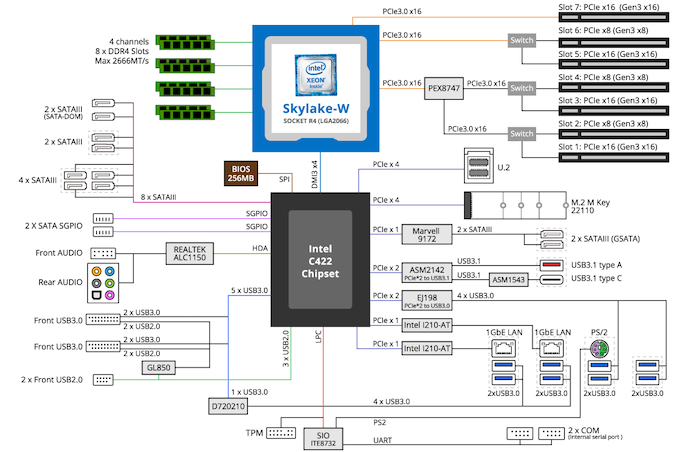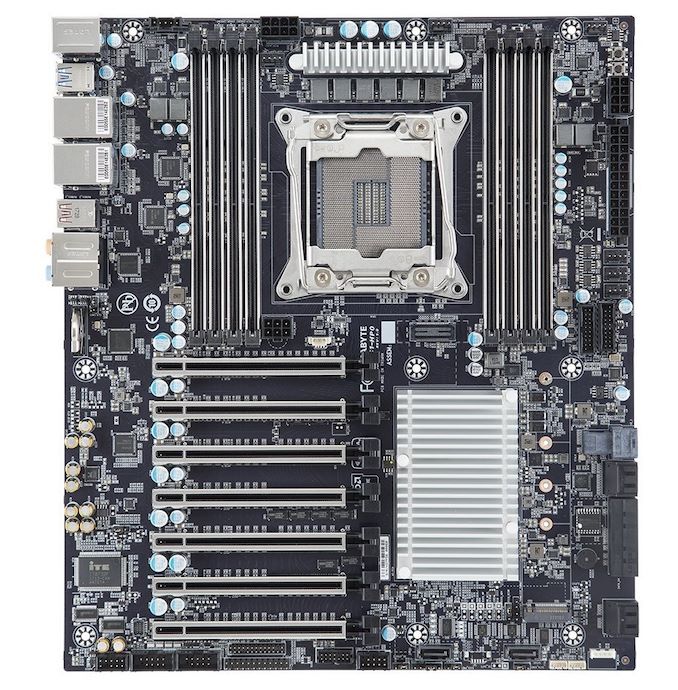The GIGABYTE MW51-HP0 Motherboard Review: Consumer Meets Workstation for Xeon W
by Gavin Bonshor on March 6, 2019 9:30 AM EST- Posted in
- Motherboards
- Intel
- Gigabyte
- Workstation
- server
- Xeon-W
- C422
- MW51-HP0

The GIGABYTE MW51-HP0 is a CEB form-factor motherboard that is aimed at users looking to build a professional workstation on the Intel C422 chipset with support for Xeon W processors. Some of the board's key features include dual Intel NICs, ten SATA ports, support for quad-channel RDIMM and LRDIMM DDR4 memory, and seven full-length PCIe 3.0 slots backed by a single Broadcom PEX8747 PLX chip.
Related Reading on C422 and Intel Xeon-W
- The Supermicro X11SRA Motherboard Review: C422 based Workstation for Xeon-W
- GIGABYTE Server Announces MW51-HP0 Motherboard: C422 for Intel Xeon-W
- The Intel Xeon W Review: W-2195, W-2155, W-2123, W-2104 and W-2102 Tested
- Intel Reveals Name of Next Generation Xeon D: Hewitt Lake
- Intel's Keynote at CES 2019: 10nm, Ice Lake, Lakefield, Snow Ridge, Cascade Lake
GIGABYTE MW51-HP0 Overview
The GIGABYTE MW51-HP0 hails from the company's server-based product stack and is specifically targeted at users looking to build a professional workstation. Intel’s Xeon-W range of workstation processors started filtering into the market in Q3 2017, with models ranging from 4-cores (Intel Xeon W-2123) all the way to 18-cores (Intel Xeon W-2195). Note however that despite the naming, the new 28-core Intel Xeon W-3175X isn’t supported by the MW51-HP0 since that that chip uses a different socket. Overall the MW51-HP0's aesthetics follow a very simple black and grey theme with silver aluminum heatsinks set upon an all-black PCB.
With a price tag of $567 from Amazon, the MW51-HP0 is a single socket workstation motherboard which offers professional features, of particular note being its seven full-length PCIe 3.0 slots, which are backed by a single Broadcom PEX8747 PLX chip. Altogether there are 64 PCIe lanes available, with the top three-slots taking lanes directly from the CPU and the remaining four being handled by the PEX8747 PLX.
On the storage side is a total of ten SATA ports with eight direct from the C422 chipset and the other two controlled by a Marvel 88SE9172 SATA controller. Other options include a solitary M.2 PCIe 3.0 x4 slot with support for M.2 2242-22110 drives and a single U.2 connector with support for mini-SAS hard drives. Intel’s VROC is supported for users looking to use a PCIe RAID array including RAID 0, 1, 5 and 10.
Memory-wise the GIGABYTE MW51-HP0 supports two types of DDR4 memory: RDIMMs up to 64 GB in capacity, and then LRDIMMs at up to 128 GB. A total of eight DDR4 slots are present and allow users to run memory in quad-channel memory mode, with a maximum capacity of up to 512 GB. The primary network controller set consists of two Intel I210-AT GbE NICs, which also offer support for teaming. Meanwhile audio support is provided by an older Realtek ALC1150 HD audio codec. USB support is extensive, with a total of sixteen ports supported and ten of those on the rear panel alone. These rear ports are split between eight USB 3.1 Gen 1 Type-A ports and two USB 3.1 Gen2 ports (Type-A and Type-C).

GIGABYTE MW51-HP0 Block Diagram
As it's been a while since our last Intel C422 chipset motherboard review, the Supermicro X11SRA, our test suite has been upgraded. In our non-UEFI POST time test the GIGABYTE MW51-HP0 emerged with the shortest boot times among the boards we tested, including booting three times quicker than the Supermicro X11SRA C422 motherboard. The results in our DPC latency test also proved advantageous with a very strong showing in comparison to our other boards. And with our gaming tests – which are designed to show consistency – the 1080p results were exactly as expected, but at 4K the performance did seem a little off the mark by a couple of frames.
Intel’s Xeon-W processors do not officially support overclocking due to being multiplier-locked. So the only way to overclock them is through the BLCK, and the GIGABYTE MW51-HP0 doesn’t include any overclocking options whatsoever. Compatible memory installed automatically runs at its rated speeds, so our Kingston 4x8GB DDR4-2666 CL19 kit's settings were applied by default, for example.
All told then, the GIGABYTE MW51-HP0 seems designed to be a serious contender in the workstation motherboard space. With its extra PCIe lanes, VROC support, and overall workstation credentials courtesy of Intel's C422 chipset, it can support the kind of heavy CPU grunt and graphics computational workloads required for virtualization, simulations and other heavy workloads. And while aesthetics aren't a priority here, for a price tag of $567, Gigabyte didn't skimp there either. So the board has all of its bases covered.
Pages In This Review
- Overview [this page]
- Visual Inspection: Analysis of the Boards Components
- BIOS and Software: Looking at the non-hardware portion
- Board Features and Test Bed: The full specifications, and how we test
- System Performance: Component testing, such as power, boot times, and DPC Latency
- CPU Performance
- Gaming Performance
- Conclusion











33 Comments
View All Comments
colonelclaw - Wednesday, March 6, 2019 - link
The lack of 10GB Ethernet mars what is otherwise an attractive bit of kit, both technically and aesthetically.imaheadcase - Wednesday, March 6, 2019 - link
Well since this board is not for %99 of readers on this site, its more than likely if you are spending that much for a board you going to get stand alone NIC for that. Anandtech likes to for some reason review stuff now that is business/IT/Phone related more than consumer stuff.Kevin G - Wednesday, March 6, 2019 - link
Big consumer stuff has, well slowed down. Sky Lake was released 3.5 years ago and since then Intel has boosted clocked, bumped up core counts and polished the chipset. AMD released Ryzen which got lots of coverage but the Zen+ refresh was mainly polishing off the first release. Zen 2 is still a little bit away so news will at least pick up on the consumer CPU side soon.The GPU side of things hasn't been that exciting as AMD and nVidia are seemingly content where they are in the market. The mining boom shifted prices upward which neither company is eager to reverse. The GTX 1660 Ti is actually a fairly big thing for consumers but that level of performance could be had years ago if you had the cash back then for a high end card. AMD's Navi will be another step forward for consumer but again will be over shadowed by the previous generation of highend hardware that carried higher prices.
I hope the next big thing is a wider product line up of gaming displays now that HDMI 2.1 has adopted variable refresh rate support, nVidia supports Freesync displays (soft of) and Intel will finally be adding Freesync support too. Things are lining up for this to go mainstream. Though much like CPU and GPU news, variable refresh rate support has been around for years on other hardware.
I see 2.5 and 5 Gbit hardware taking of on the consumer side along with 802.11ax (Wifi 6) enabled devices. Wireless is starting to move beyond a gigabit of bandwidth so the wired side of connectivity also has to evolve. Though it feels odd celebrating the release of 2.5 and 5 Gbit speeds when 10 Gbit has been around for years.
If you want a real wide guess of what the next big consumer thing will be that really hasn't spread in the high end yet would be network based audio transport. Stuff like PoE enabled network speakers that integrate with other smart home devices. Stuff like this exists on the professional side of things but even there you'd have to look for it.
gavbon - Friday, March 8, 2019 - link
Prosumer boards serve a purpose just as much as consumer desktop boards. I personally like focusing on consumer boards, but when I get asked to look at workstation boards, it makes a nice change!PeachNCream - Friday, March 8, 2019 - link
I would question the accuracy of the 99% statistic regarding readers. While I am myself a consumer as an individual, my profession is in enterprise computing and networking so products outside of the consumer space are of an interest to me as much as are consumer electronics. I think quite a few of us are in a similar state, working in information technology and reading to stay caught up on broader developments. Sure, individual workstation motherboards are a bit of an oddity as most workstations are major muscle movement purchases that are acquired from hardware company like HP or Dell, but they are still relevant so I'm happy to see them getting a little word count now and then.CheapSushi - Thursday, March 7, 2019 - link
Not even 10GB but 2.5G and 5G at least, especially now that controllers are more affordable. 2.5G should be basically standard now in 2019.Kevin G - Wednesday, March 6, 2019 - link
Typo on the first page:"A total of eight DDR4 channels are present and allow users to run memory in quad-channel memory mode"
I believe you mean eight DIMM slots in quad-channel memory mode.
Ryan Smith - Wednesday, March 6, 2019 - link
Thanks!Sivar - Wednesday, March 6, 2019 - link
You see, this is how to report a typo (or "thinko"). No sarcasm, attacks, or diatribe about how Anandtech must be a shill for the reviewed item's manufacturer.Just polite, factual, and tactful. Thank you!
kalm_traveler - Wednesday, March 6, 2019 - link
The Xeon W-3175x is not a 32 core chip; it is 'only' 28 core.